The Russian Baltic Fleet, under Vice-Admiral Rozhdestvenski, on its way from Europe to Vladivostok, was totally defeated on May 27 1905, by the Japanese Fleet, under Admiral Togo, in the Strait of Tsushima, at the entrance to the Sea of Japan
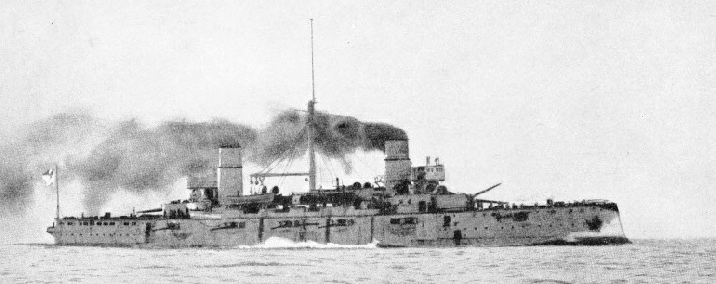
IN ADMIRAL TOGO’S FIRST SQUADRON was the Japanese armoured cruiser Nisshin, formerly the Moreno. She was launched for the Argentine Navy in 1903 and completed at Sestri Ponente, Italy, in 1904. She had a displacement tonnage of 7,700. Her length was 344 feet, her beam 59 ft. 9 in. and her draught 24 ft. 3 in. This vessel was one of twelve Japanese ships fit to lie in line-of-battle.
IN the Korea Strait, just a hundred years after Trafalgar had been fought under sail, there was contested the first decisive naval battle of the steamship age in accordance with modern ideas. It is true the battle of Lissa (1866) remains notable, because until that action squadrons of ironclads had never before fought together; yet, for a variety of reasons, Lissa cannot compare with Tsushima. Nor can the battles of the Yalu (1894), in the Chino-Japanese War, or of Santiago (1898), in the Spanish-American War.
Lissa indicates but the half-way stage in the development from the old wooden three-decker to the steel battleship. Moreover, by one of those strange recurrences of human heresies, we find in Lissa a revival of that ancient idea of the ram, which was already waning after the battle of Lepanto, and gradually received disfavour universally. The transition of the capital ship between 1805 and 1905 was from traditional conservatism towards a man-of-war built in accordance with the latest scientific knowledge. Nelson’s vessels had a mixed armament, and they could hit only at point-blank range. The Victory and her immediate successors had nearly reached the limit of size for timber-built ships, but the adoption of iron was about to solve that problem. After a French officer’s suggestion that the general use of shell would be preferable to the old custom of solid shot, there came opportunity for proof during the destruction of the Turkish fleet at Sinope, in the Black Sea, in 1853. But no later than sixteen years after Nelson’s death, a vast change was foreshadowed when the Admiralty bought its first steam vessel.
About 1840, British and other navies began to introduce wooden paddle frigates, though ten years later the screw sought to win a reluctantly conceded popularity. The nineteenth century was essentially an era of experiment, of adopting new principles and then going back to old ones —sometimes too, of trying to combine both. For example, as late as the period 1855-60, a number of wooden three-deckers were launched. In spite of having sails and yards, the old-fashioned square ports and Nelsonian hull, the multiple armament of 121 guns, and projectiles not dissimilar to those of Drake’s time, these vessels were fitted with steam-engines and screw propellers.
H.M.S. Howe represented one of the last three-deckers, but the Crimean War definitely proved that an unprotected hull was no match against shell fire. Therefore the French began to use 5-in. armour-plating with wood backing in the year 1859. The industrial age began to use iron with increasing success, and we next find France building La Gloire as the first ironclad, and Great
Britain producing H.M.S. Warrior, that historic iron screw frigate of 9,210 tons displacement protected with 4½-in. armour. Moreover she mounted rifled breech-loading guns, later replaced with rifled muzzle-loaders. It is directly from the Warrior that the modern super-dreadnought is descended, and the race between artillery and armour — shells versus protection — has not finished yet.
The use of the word “ironclad” accentuates the defensive attitude which our forefathers had adopted in mid-Victorian days, whereas in the time of Nelson and to-day we find stress laid on a ship’s offensive character, reckoned in terms of gun-power. But in the Lissa action a division of one of the fleets sought to use the iron ram as the Mediterranean galleys had used the bronze beaks. The essential difference was that steam power took the place of oars and rowers. That Adriatic battle of 1866 was, however, required to prove once more two notable facts — the difficulty of hitting, and the serious injuries which the attacking ship must suffer if lucky enough to strike her opponent.
During the war of 1914-18 there were some minor occasions when British destroyers rammed the enemy. For instance, in the Dover Straits the Broke struck a raiding German destroyer. It was a magnificent effort, but the Broke received such serious damage that she had to spend a long while in dockyard hands being repaired.
In spite of the use of steam-driven ships, the battle of Lissa added little to naval knowledge that was not already known. Such slight war experience had been gained since Trafalgar. So many revolutionary improvements had been made in the fighting ship since the introduction of armour, rifled guns, steam and so forth, that, when the Russo-Japanese War broke out, an exceptional interest was born. Here would be a unique chance for testing theories, for observing whether naval shipbuilding policy in recent days had been progressing on right lines, and whether tactical ideas needed revision.
Otherwise, millions of money and years of effort spent in national defence had been wasted. There existed a possibility that the Admiralty mind had overstressed one idea and underestimated the value of another. Only a serious fleet action could provide clear-cut, accurate conclusions. Especially appreciated would be information on the value of speed in battle, the relation of guns and armour to victory, the correct tactical employment of steam-driven squadrons, and the frequency of hitting, rather than the weight of shells.
Rival Ambitions
The battle of Tsushima afforded lessons which immensely influenced the British Navy. We shall scarcely exaggerate if we claim that Tsushima had a greater effect than was exercised by any sea-fight of the early twentieth century. The rise of Japan to the rank of a leading nation logically followed, because her seafaring people appreciated the value of naval strength.
Steady improvement of a country towards material prosperity inevitably inspires jealousy which, in turn, brings about the great clash to be settled only by rival fighting forces. At the battle of the Yalu it had already been shown, during the war of 1894-95 against China, that the Japanese fleet would have to be reckoned with in the future. The remaining decade was enough for self-confidence, born of success, to wax strong.
The rival ambitions of Japan and Russia in the Pacific failed to be settled without resort to war. The trouble originated when Russia longed to see herself a naval Power in that ocean. Desiring a harbour free from ice all the year round, she had secured from China a lease of Port Arthur, which was deepened, and the Trans-Siberian Railway was extended to that port. The transfer of Port Arthur while Japan was in possession after the Chino-Japanese War had aroused intense feeling in Japan. By 1903 Russia was at loggerheads with Japan about the control of Southern Manchuria and Korea. Finally, in the following February, Japan withdrew her Minister, the Russian squadrons in Chemulpho and Port Arthur were attacked, troops were landed, and with remarkable promptness hostilities developed.
The Russian warships Variag and Korietz lying in Chemulpho were so damaged that they sank. Admiral Togo’s smaller craft made an onslaught against the Russian ships lying off Port Arthur and badly damaged the Cesarevitch, Retvizan and Pallada. On the following day the Poltava, Novik, Askold and Diana were all badly damaged. Later on the battleship Petropavlovsk sank on mines, three destroyers were interned after reaching Tsing-Tao, others were interned elsewhere, and the Vladivostok squadron came to grief on its way to help the Port Arthur ships. Russian naval power in the Pacific was wiped out, and the Japanese had command of the sea.
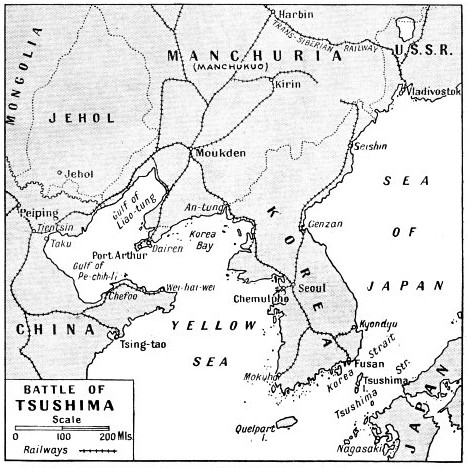
AT THE ENTRANCE TO THE SEA OF JAPAN, the island of Tsushima divides the Korea Strait into two channels, the wider (eastern) channel—Tsushima Strait—being eighty miles across. The Russian Baltic Fleet, which had left the Baltic in September 1904, and Shanghai on May 25, 1905, bound for Vladivostok, had a choice of three routes—east of Japan by the outside route or west of Japan by the inside route east or west of Tsushima Island. The distance by the inside route from Shanghai to Vladivostok was over 1,000 miles. Admiral Togo, Commander-in-Chief of the Japanese Fleet, rightly concluded that the Russians would take the inside route through Tsushima Strait. In the afternoon of May 27 the rival fleets engaged and the Japanese were completely successful.
In September 1904 Russia sent out her Baltic Fleet under Vice-Admiral Rozhdestvenski, his flag flying in the Kniaz Suvoroff (13,600 tons, nominal speed 18 knots). It was an ambitious project to voyage across the world in this fashion, but the result could be foreseen. Temperamentally the Russians of that day were unsuited for sea warfare — slovenly, afflicted with pessimism, inert, with little professional ability. Many of them were inspired with revolutionary feeling. Their squadrons had wasted too long a time in harbour, and the training at sea had been far too slight. Neither officers nor men were efficient, and all knew that they would have little chance if they met the Japanese.
Nor had Rozhdestvenski steamed across the North Sea before a display of nervousness was made off the Dogger Bank. It was night time, and some British East Coast steam trawlers were fishing as normally, when the Russians took them to be Japanese torpedo-boats, opened fire and sank some of them. That unfortunate and stupid beginning eventually cost the Russian Government £65,000 by way of compensation, and the admiral’s blunder nearly caused an Anglo-Russian war.
The Baltic Fleet steamed down the English Channel, Bay of Biscay, and round the south of Africa, being joined towards the journey’s end by another squadron under Admiral Nebogatov, who had not left Russia until February. The difficulties and anxieties of Rozhdestvenski during these eight months’ steaming were enormous, and the essential matter of coal never ceased to be a worry. But the fleet had to do its best to reach Vladivostok, even if the decks and some officers’ cabins were piled with coal, and the ships were loaded down until their armour belts were submerged.
On May 25 this sea-stained weary fleet, after two days at Shanghai, began the last stage of its sad progress. Neither ships nor personnel, neither hulls nor engines, were in the best condition for fighting a decisive action against a keen young navy, already flushed with victory and in a state of great material efficiency.
The Russian fleet consisted of three armoured squadrons, a cruiser squadron, a scout division and two cruisers to co-operate with nine destroyers. All the transports, except those carrying naval war stores, were left at Shanghai. Ahead steamed the scouts Svietlana, Almaz and Ural in wedge formation, followed by two columns. The starboard column comprised the First Armoured Squadron, made up of the Kniaz Suvoroff (flag), Alexander III, Borodino and Orel, and the Second
Armoured Squadron, made up of the Oslyabya (Flag of Rear Admiral), Sissoy Veliky, Navarin and Admiral Nakhimoff. The port column consisted of the Third Armoured Squadron — Nicolai I, Admiral Senyavin, General Admiral Graf Apraxin and Admiral Ushakoff — and the cruisers Oleg, Aurora, Dmitri Donskoy and Vladimir Monomakh, with which were five torpedo boats that were to help in protecting the transports On either beam of the leading ships, and parallel with them, were the 23-knots cruisers Zemtchug and Izumrud, each accompanied by two destroyers.
Vladivostok the Russian Goal
In the rear of the two columns steamed the remaining vessels. These had no fighting value and were an encumbrance. They included the transports Anadir, Irtish, Korea and Kamchatka, the repair and steam-tugs Svir and Russ, and the two hospital ships Orel and Kostroma. It may seem amazing that these eight vessels should be accompanying a fleet expectant to enter battle, but Rozhdestvenski’s orders were that he should force his way through to Vladivostok, and he was to take with him everything in the way of materials and supplies. The Trans-Siberian Railway could do little more than keep the Russian army supplied.
The armament of the four ships in the first squadron was four 12-in. and twelve 6-in. guns to each unit. The second four ships, whose admiral died shortly before battle, were variously armed. The Oslyabya had four 10-in. and eleven 6-in. guns, the Sissoy Veliky four 12-in. and six 6-in. guns, the Navarin four 12-in. and eight 6-in. guns, and the Admiral Nakhimoff eight 6-in. and ten 4.7-in. guns. The four ships of the third squadron between them mounted two 12-in., three 10-in., eight 9-in., twelve 6-in. and twelve 4.7-in. guns. These twelve armoured vessels were to compose the battle fleet.
Of the cruisers there were four (each displacing about 6,000 tons), with a united broadside of twenty-seven guns, of either 6-in. or 4.7-in. calibre. The other four cruisers were about half this size, offering a broadside of sixteen guns — chiefly 4.7-in.
The Japanese numbered twelve ships fit to lie in line-of-battle, composed of two squadrons. The Mikasa, of 15,140 tons displacement (flying Admiral Togo’s flag), Shikishima, Fuji, Asahi, Kasuga and Nisshin, formed the first. The second squadron was made up by the Idzumo, Yakumo, Asama, Adzuma, Tokiwa and Iwate. The first squadron had a broadside of sixty-three guns, including sixteen 12-in. and forty 6 in. The second squadron consisted of vessels of about 10,000 tons able to fire a broadside of sixty-four guns, either 8-in. or 6-in. The total armament of the Japanese squadrons was: first squadron, sixteen 12 in., one 10-in. six 8-in. and eighty 6-in. guns; second squadron, twenty-four 8-in. and eighty 6-in. Guns.
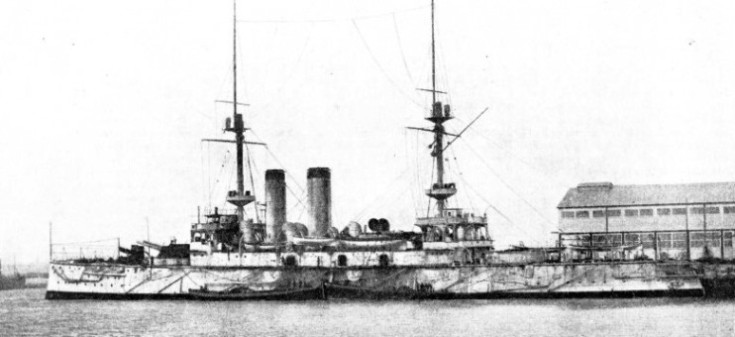
A UNIT OF THE JAPANESE FIRST SQUADRON, the battleship Asahi. She had a displacement tonnage of 15,200. Her length was 400 ft. 6 in., her beam 75 ft. 3 in. and her draught 27 ft. 6 in. She was launched in 1898 and completed in 1899 at Elswick (Northumberland). The Japanese first squadron, led by the Mikasa (15,140 tons displacement) flagship of Admiral Togo had a total armament of sixteen 12-in. one 10-in., six 8-in. and eighty 6-in. guns, and was able to fire a broadside of sixty-three guns.
The Japanese had sixteen cruisers, as well as over 100 torpedo boats or destroyers, besides smaller cruisers to co-operate with these mosquito craft. They were able to oppose 127 guns against the enemy’s 98, and to steam at 15 knots compared with the Russian 11 knots. Therefore long before the two fleets met, Togo was superior in the two most essential items. It remained only to see whether his tactics would allow these to be used to their fullest advantage. And this, in any critical stage of a fleet action, might be the cause of victory as of defeat.
In secondary armament the Japanese were still further superior to their enemy, and herein was a notable factor. During the important phase of the fighting these lighter guns (especially the 6-in. quick-firers) played a conspicuous part. Not the weight, but the frequency of shells was to overwhelm the Russians.
Admiral Togo, who had received part of his education in the British training-ship Worcester on the Thames, was supported by vice-admirals and rear-admirals who were his old friends and pupils He himself had commanded his squadron continuously for eight years. Thus there existed a unity and mutual trust, an understanding and reliance, which were of considerable moral value to the fleet. Rozhdestvenski’s preparation for meeting the enemy was marked by muddled reasoning. He failed to appreciate that, before he could arrive with his fleet, transports, stores and repair-ships, he must first defeat the enemy and win a free passage. The famous naval historian, the late Admiral Mahan, who more than any other writer influenced modern navies, once remarked that the Russian admiral’s “management of the preparation for meeting with the enemy appears to me as a whole so blundering that I am forced to the conclusion he had never clearly thought out his strategic problem.”
A Squadron of “Self-Sinkers”
For an admiral learns his job by long years at sea and by cruising and exercises, not by last-minute improvisation on the way to the fight. Rozhdestvenski’s ships were a mere rabble when they crossed the Dogger Bank, yet they had learnt a little even by the time they reached Madagascar. Admiral Nebogatov, with the untrained third squadron, did not join up with the fleet till May 9. The vessels of this squadron were so wretched that the Russian officers themselves contemptuously referred to them as “self-sinkers”.
On the evening of May 25 one of the third squadron, the Admiral Senyavin, broke down. This delayed the whole fleet. Next, when the Commander-in-Chief was forming his squadrons in order
of battle, the manoeuvre was ruined by Nebogatov’s ships, which did not know their work. They had been insufficiently exercised Apart from the condition of boilers and machinery which had made martyrs of the engineering staffs, the fleet was not supplied with such modern explosive shells as had recently been issued to the Japanese.
Togo knew that the Russians had left Shanghai, but he could not be sure whether his enemy would come east or west of Tsushima Island, which divides the Korea Strait into two channels. As the eastern channel is the wider, measuring about eighty miles across, he inferred that Rozhdestvenski would prefer it to the western channel, which had half that width. Sixty miles to the south of the island Togo’s cruisers were spread as look-outs, and ahead of them were stationed the Sinano Maru and other Japanese armed merchantmen.
It seemed improbable the Russians would make towards Vladivostok by the outside route east of Japan, and it would be impossible to pass through the strait, even in fog or bad weather, without being noticed. The long line of warships and transports could not hope to avoid detection in the most favourable conditions, and stragglers there certainly would be. By the inside route the distance from Shanghai to Vladivostok was over one thousand miles.
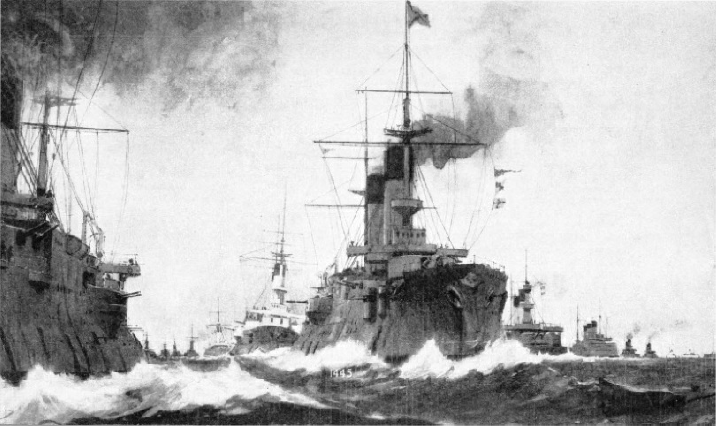
THE RUSSIAN BALTIC FLEET. In the centre foreground is the Kniaz Suvoroff, Vice-Admiral Rozhdestvenski's flagship, sunk in the action. To the right are the Admiral Ushakoff (sunk), Zemtchug (escaped), Admiral Senyavin (captured), General Admiral Graf Apraxin (captured), Kamchatka (sunk), Irtish (sunk) and Svietlana (sunk). To the left of the Kniaz Suvoroff are the Alexander III (foundered), Admiral Nakhimoff (sunk), Dmitri Donskoy (sunk), Vladimir Monomakh (foundered), Borodino (sunk), Nicolai I (captured), and (on extreme left) Orel (captured). The Orel, illustrated also below, was a unit of the Russian Volunteer Fleet. In the battle of Tsushima the Japanese sank, disabled or captured eight battleships, nine cruisers, three coastal defence ships, nine torpedo craft, one auxiliary cruiser, six special service steamers and two hospital ships. The Japanese loss was three torpedo boats. The illustration is from a drawing by Norman Wilkinson.
On May 26, as the Russians were sweeping north-eastwards in the direction of the defile, they picked up some of the Japanese wireless signals. These evidently had come from the look-out cruisers reporting nothing in sight. At sunset the Russian. fleet closed up in readiness for an attack by torpedoes. On the fore-bridge, dozing in his chair, reclined Rozhdestvenski. To-morrow was to be the culmination of his eight-months’ troubles.
Dawn came about 5 a.m. Darkness had hidden the Russians so well that only now did the Sinano Maru almost run into the line towards its end. She sighted the hospital ships in the rear, and forthwith she flashed news of the fleet’s discovery northwards where Togo with his fleet lay off Fusan. From the Japanese wireless signals which now were intercepted Rozhdestvenski knew what to expect, and recalled his three scouts (Svietlana, Almaz and Ural) to the rear for the purpose of protecting the unfortunate transports. At 6.45 a.m. a Japanese cruiser was sighted and recognized as the ldzumi, but she soon withdrew. She had confirmed to Admiral Togo the necessary information.
Any moment now the Russians expected to observe the foe in strength. At 8 a.m. four more strangers came out of the mist and were identified as the Japanese First Cruiser Division. They retired to the north, where they soon disappeared. Two hours later the Third Cruiser Division also appeared. The Russian admiral now formed battle-line of his three armoured squadrons. His cruisers covered the transports on the port side. At 11.20 a.m., by an accidental shot fired by the Orel, fourth ship in the Russian First Armoured Squadron, other ships in the fleet were induced to open fire also, which caused the Japanese cruisers to make off in the direction of Togo.
By noon the Russians were abreast the southern end of Tsushima and steering almost north for Vladivostok. About half an hour afterwards a typical muddle occurred. Some Japanese light cruisers with torpedo boats appeared on the port bow crossing ahead of Rozhdestvenski, who suspected an intention of minelaying.
A Japanese Tactical Error
Rozhdestvenski therefore ordered the first squadron to turn away to starboard 8 points (90 degrees); this manoeuvre was to be followed by another 8-points turn together to port. The Borodino and the Orel, however, misunderstood the latter half of the signal, and the formation was temporarily spoiled. There might have been serious results, but the enemy ran off and order was restored. Finally, about 1.20 p.m. the three squadrons were again in single-line and Togo’s main force could be seen approaching through the mist. There they were — the whole battle fleet of a dozen ships — six miles to the north-east.
When a squadron or fleet is ordered to turn “together” 8 points this means that simultaneously each ship will turn at right angles to her course. Thus, instead of (say) four ships steaming in single-line ahead they now proceed in line abreast. Supposing they had been following their admiral due north, and the order came “Turn together 8 points starboard”, they would all be steering eastwards parallel, and not in line, with one other. If the next order were “Turn together to port”, they would again be in single-line ahead steering northward. But turning “in succession” means each ship must not alter course until she reaches the spot where her next ahead had just turned. In other words, No. 2 follows No 1, No. 3 follows No. 2, and so down the line.
Togo’s ships coming south now turned “in succession” to the north-west and then to west. Next, they turned “in succession” to the south-west, so as to make the Japanese seem about to pass the Russians on parallel but opposite courses. At 1.45 p.m. Togo’s flagship Mikasa gave the signal to alter course “in succession” east-northeast, across Rozlidestvenski’s bows. This was the most interesting moment in the whole fight, and Togo perpetrated such a tactical error that any opposing fleet except the Russian would have beaten the Japanese and won the battle. For if a fleet of twelve ships is to turn “in succession” when steaming single-line ahead, the turning-point — the elbow, so to say — remains a fixed target for a matter of minutes. If you keep firing at this stationary elbow, you may hit each of the dozen ships one after the other.
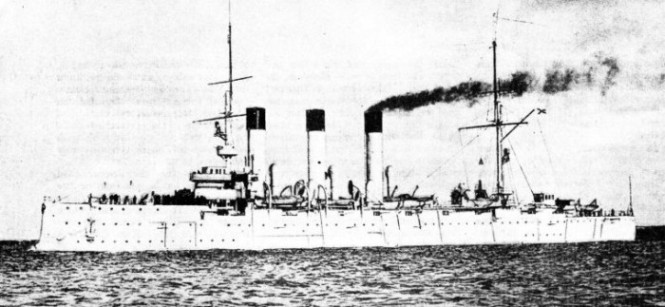
A RUSSIAN CRUISER, the Aurora, a unit of the port column of the Russian Baltic Fleet. The Aurora had a displacement tonnage of 6,731. Her length was 413 ft. 3 in., her beam 55 ft. 9 in. and her draught 21 feet. She was launched in 1900 and completed in 1902 at St. Petersburg (now Leningrad).
The next astern of the Mikasa was the Shikishima, and by 1.49 there were still ten more to come. Even the Russians marvelled at Togo’s rashness. Rozhdestvenski now opened fire from the Kniaz Suvoroff, the range being only 6,400 yards; yet the gunnery and shells were so bad that this tactical opportunity was utterly lost. On the contrary, the Japanese quickly got the range and shells burst with no uncertain effect. The Russian stretcher parties were soon performing their sad tasks amid smoke and conflagrations. The Kniaz Suvoroff was being torn to pieces, guns were hurled from their mountings and steel plates crumpled as if they were paper. Togo’s idea was to pour forth the greatest volume of fire in the shortest time, so as to paralyse the flagship; and, having finished turning “in succession”, he went ahead but parallel with his enemy.
The next phase began at 2.5, when Togo’s fleet inclined to starboard with an intention of crossing the Russians’ T. To “cross the T” is the admiral’s modern aim in action. The horizontal part of the letter represents his own fleet, and the vertical portion the enemy’s. For, by making a right angle, the former is in a position to bring the whole of a fleet’s broadside upon a foe who can fire only directly ahead. Rozhdestvenski understood this and bore away to starboard. The fight proceeded on parallel courses, but this time the Russians had their enemy almost on the beam.
The better trained Japanese gunners, firing shells whose bursting charge was seven times more powerful than that of the Russians, were so successful that the Kniaz Suvoroff, with her wrecked rangefinders, her after-turret blown up, her foremost funnel knocked down, and her crew almost panic-stricken, was in a bad way. It was now about 2.15 p.m., and a few minutes later Togo, inclining still farther to starboard in another effort to cross Rozhdestvenski’s T, drove the Russian to turn likewise. Finally, with her steering gear jammed and her foremast and both funnels gone, the Russian flagship swept out of the line, battered and burning.
Her place was taken by the Alexander III, second ship in the line, which had to swerve to starboard till she headed south, such was the pressure by the speedier Japanese fleet. When the Oslyabya, flagship of the Second Squadron, also quitted the line, the remaining units were thrown into confusion and the third squadron found itself ahead of the second. But the contest of wits went on and Togo was resolved not to repeat his initial mistake. To press the enemy still more, he turned his squadton “together” 8 points to port, and then to port again 8 points. At 2.50 this manoeuvre was met by the Russians turning to starboard in succession 16 points.
Baltic Fleet Annihilated
When Vice-Admiral Kamimura, with the second Japanese squadron, turned and passed the Russians, the Russians made another mistake in throwing their guns off the target. Thus by 4 p.m. the battle of Tsushima had been won. In addition to her injuries, the Kniaz Suvoroff could scarcely steam, for the ventilators were bringing down smoke instead of fresh air, and the engine-room people were being suffocated. Rozhdestvenski, seriously wounded, was taken off by a destroyer in the conditions of a fresh breeze, Pacific swell and dusk. At 5.30 p.m. the Alexander III foundered. Two hours later, in the darkness, the Japanese destroyers and torpedo-boats arrived and their torpedoes finished off several ships that were already damaged. Next morning the surviving four units were compelled to surrender, and the destroyer carrying Rozhdestvenski was chased and captured. Togo had sunk, disabled, or captured no fewer than eight battleships, nine cruisers, three so-called coast defence ships, nine torpedo craft, one auxiliary cruiser, six special service steamers and two hospital ships. The Japanese themselves had lost no capital ship and only three torpedo boats. Even Nelson would have been content with such a smashing victory. Out of the entire cavalcade, which had left the Baltic bound for Vladivostok, only one cruiser and two torpedo craft ever reached their port of destination.
The battle of Tsushima was followed in August by the signing of the Treaty of Portsmouth in the United States, but Russia never recovered from the shock of her defeat. Nominally the engagement lasted an afternoon, a night and part of the following day. Technically it was lost and won within the first hour, though before a shot had been fired, and even before the Russian fleet left the Baltic, the issue had been decided, because victories are often settled before the outbreak of a war.
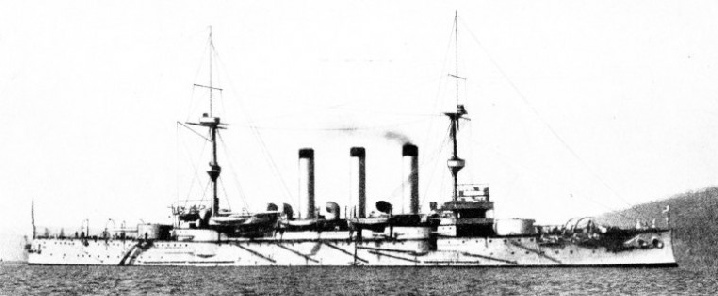
THE JAPANESE ARMOURED CRUISER IWATE, a unit of the Japanese second squadron at the battle of Tsushima. The Iwate had a displacement tonnage of 9,750. She was 400 feet long and had a beam of 68 ft. 6 in. and a draught of 24 ft. 3 in. She was launched in 1900 and completed at Elswick (Northumberland) in 1901. The Japanese second squadron was able to fire a broadside of sixty-four 8-in. and 6-in. guns; its total armament was twenty-four 8-in. and eighty 6-in. Guns.
But Tsushima was decisive in a much wider sense. If it admitted Japan into the aristocracy of nations, it rendered Russia ripe for future revolution after discontent had slowly made itself felt. It put a stop to Russian aspirations in the Far East, lowered her prestige, and reduced one menace against the British Empire, but at the same time it freed Germany of a military ascendancy on her eastern frontier, and only nine years later Germany was ready for the European war of 1914-18.
For Japan this sea-fight meant much. Had Togo been beaten, the Japanese army on the mainland could not have been supplied with food, ammunition, and other requisites. Togo well realized this when signalling to his fleet that the fate of the Japanese Empire depended on Tsushima. There were so many illuminating features of this Russo-Japanese War that the British official history of it had not been concluded by the time that Jutland was fought. Yet sufficient lessons had been acquired to emphasize the need for naval officers to study the theory of war. Training and staff work were now considered not less important than “spit-and-polish” traditions. The art of gunnery improved beyond all recognition, specialization became more than ever requisite and technicians were provided with a new set of data upon which to work.
In the Russian Baltic Fleet at the battle of Tsushima there was little basis for inspiration to fall back upon when everything went wrong, and the “all-is-lost” pessimists ruined a ship’s moral. Discipline collapsed, hope was swallowed up in panic, and an air of artificiality suggested a Russian tragic ballet rather than a turning point in Russian history.
It is not rare in naval history for an admiral to be compelled during engagement to shift his flag from one ship to another. During the battle of the Dogger Bank, for instance, on Sunday, January 24, 1915, after the battle cruiser Lion had been injured by the enemy, Admiral Beatty summoned the destroyer Attack alongside. In her he raced at full speed to rejoin the rest of his squadron, and an hour later hoisted his flag in H.M.S. Princess Royal.
An Inspired Manoeuvre
So, too, at Tsushima when Rozhdestvenski was badly wounded and his flagship damaged, the destroyer Buiny was semaphored to come and take the admiral off. To steam a light craft alongside a big man-of-war while the latter is under way in the open sea is one of the supreme tests of good seamanship. Only those who have experienced these anxious moments know what it means to avoid being fouled by some projection or being smashed up in going alongside the armoured hull. Admiral Beatty in his official report went out of his way to mention “the good seamanship” of the Attack’s captain. But the Buiny’s commanding officer had the harder task.
She should have come up to leeward, but the Kniaz Suvoroff was all flames and smoke on the lee side. So the Buiny had the difficult task of approaching the windward side, avoiding the crippled
guns projecting out of the battered gun ports, and risking being smashed by the ocean swell against the Kniaz Suvoroff's uninviting hull. The big ship’s broken torpedo-net booms did not make the job any easier. Rozhdestvenski originally intended transferring his flag to another ship, but he was suffering from severe injuries and there was great difficulty in getting him out of the conning-tower.
All this time the Buiny kept leaping skywards and then dropping down, until the unconscious admiral was half dragged, half carried to the Kniaz Suvoroff’s side, thence slid down on sailors’ backs to the destroyer’s deck.
To Vice-Admiral Nebogatov fell the duty of commanding the tattered fleet, though not for long. In the dusk, still enveloped in flames and pouring out smoke, the Kniaz Sutoroff was discovered by Japanese torpedo boats deserted and with a heavy list. It needed little more now to give the stricken ship a knockout blow, and at 7 p.m. the flagship disappeared below the rough waters of the Pacific.
The Russian cruiser Askold survived the Russo-Japanese hostilities, and even took part in the operations off the Dardanelles during the war of 1914 -18, but Russia’s new fleets in the Baltic and the Black Sea never obtained the requisite spirit. The shock of Tsushima would need generations before recovery could be obtained.
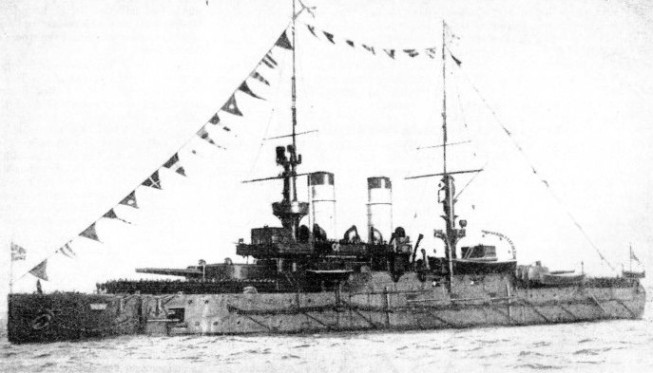
IN THE RUSSIAN SECOND ARMOURED SQUADRON was the battleship Sissoi Veliky. This vessel, of 10,433 tons displacement, had a length of 341 feet, a beam of 65 ft. 6 in. and a draught of 24 feet. Her armament included four 12-in. and six 6-in. guns. She was launched in 1394 and completed in 1897 at St. Petersburg (Leningrad). The Second Armoured Squadron was led by the Oslyabya.
You can read more on “The Imperial Japanese Navy”, “Japanese Shipping” and “Russian Shipping” on this website.









